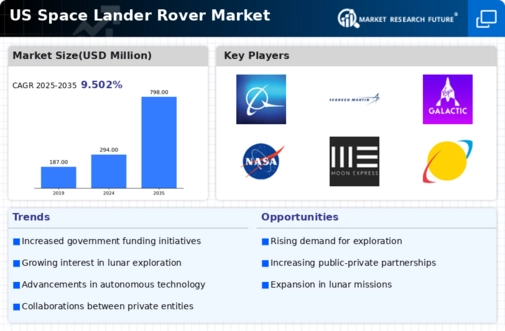The space lander-rover market is characterized by a dynamic competitive landscape, driven by advancements in technology, increasing governmental and private sector investments, and a growing interest in planetary exploration. Key players such as NASA (US), SpaceX (US), and Lockheed Martin (US) are at the forefront, each adopting distinct strategies to enhance their operational capabilities. NASA (US) focuses on innovation and collaboration, particularly through its Artemis program, which aims to return humans to the Moon and establish a sustainable presence. SpaceX (US), on the other hand, emphasizes rapid development and cost efficiency, leveraging its reusable rocket technology to reduce launch costs significantly. Lockheed Martin (US) is strategically positioned through partnerships and acquisitions, enhancing its capabilities in robotic exploration and lander development, thereby solidifying its role in upcoming missions.
The business tactics employed by these companies reflect a concerted effort to optimize supply chains and localize manufacturing processes. The market appears moderately fragmented, with a mix of established players and emerging entrants. The collective influence of these key players shapes a competitive structure that encourages innovation while also fostering collaboration, particularly in joint missions and technology sharing.
In October 2025, NASA (US) announced a partnership with SpaceX (US) to develop a new lunar lander designed for the Artemis III mission. This collaboration is significant as it combines NASA's expertise in space exploration with SpaceX's advanced technology, potentially accelerating the timeline for lunar missions and enhancing the capabilities of future landers. The strategic importance of this partnership lies in its potential to streamline operations and reduce costs, thereby making lunar exploration more feasible.
In September 2025, Lockheed Martin (US) unveiled its latest rover prototype, which incorporates AI-driven navigation systems. This development is crucial as it positions Lockheed Martin to lead in autonomous exploration, a key requirement for future missions to Mars and beyond. The integration of AI not only enhances operational efficiency but also reduces the need for human intervention, thereby minimizing risks associated with remote operations.
In August 2025, SpaceX (US) successfully launched its Starship vehicle, which is intended to support both lunar and Martian missions. This launch is pivotal as it demonstrates SpaceX's commitment to developing a versatile platform capable of supporting a range of exploratory missions. The implications of this success extend beyond immediate operational capabilities, as it reinforces SpaceX's position as a leader in the space industry, potentially attracting further investment and partnerships.
As of November 2025, the competitive trends in the space lander-rover market are increasingly defined by digitalization, sustainability, and the integration of AI technologies. Strategic alliances are becoming more prevalent, as companies recognize the value of collaboration in achieving ambitious exploration goals. Looking ahead, competitive differentiation is likely to evolve, shifting from traditional price-based competition to a focus on innovation, technological advancements, and supply chain reliability. This transition suggests that companies that prioritize research and development, alongside strategic partnerships, will be better positioned to thrive in an increasingly complex and competitive environment.























Leave a Comment